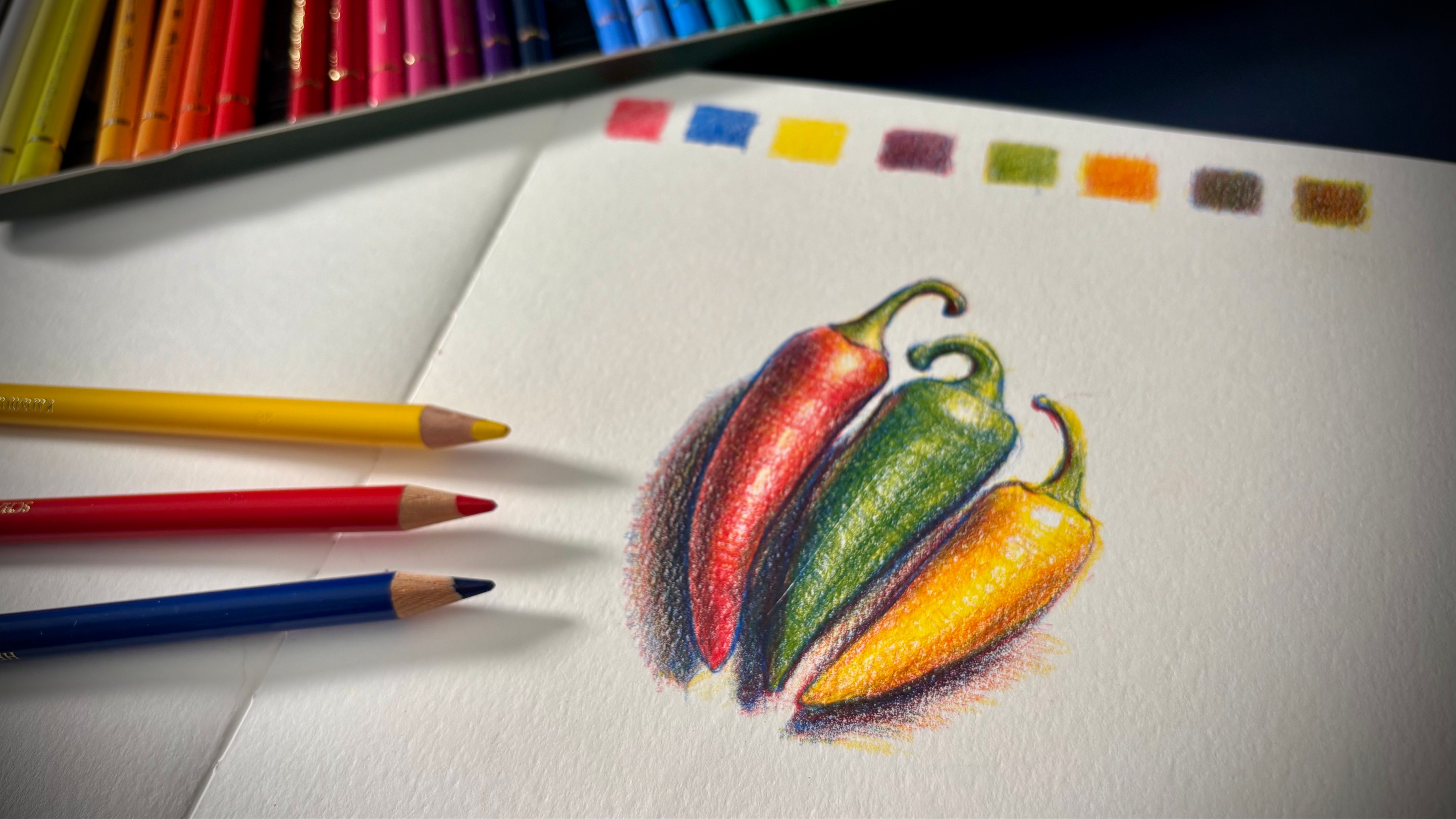
A Complete Guide to Choosing An Easel
May 05, 2022By Bob Davies
So you're fed up working with your paper or canvas flat on the kitchen table because it hurts your back leaning over it, whether you're standing or sitting?
And you're trying to work in your own shadow?
Or you're in full flow but then have to move everything as the table needs to be set for dinner?
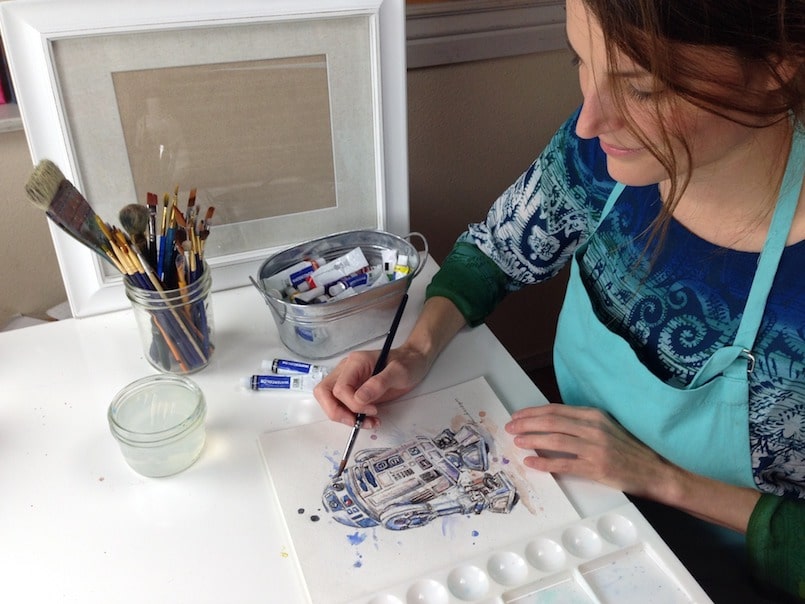 [Photo credit: Pixabay]
[Photo credit: Pixabay]
And you spill paint or water on the picture while you're moving it, ruining several hours effort?
"Oh, for an easel to work from" you wish wistfully to yourself.
Yes, but which one - there are hundreds...?
Now It's fair to say that most people when they begin to draw or paint seriously, don't actually own an easel unless they've inherited one from somewhere.
In fact, very often, the first time they use a 'proper' easel is when they attend a night school class where several free-standing easels will already be set up in a studio environment.
At that point, mild panic sets in as they walk in the room and strive to look familiar with the workings of the contraption in the gaze of the other students, adjusting the height and angle of the easel, finding how to place their paper or canvas securely on it and generally get to grips with the various knobs and levers.
Setting up a deck-chair looks a breeze in comparison.
They then cause much merriment to the rest of the class as they make an adjustment too far and the whole thing collapses in a heap of disconnected wood and paint-spattered canvas across the studio floor.
"Oh look, an abstract", is the unnecessary observation of a giggling classmate...
Now, of course, you may never intend to do other than some quick sketches in a sketchbook, or the occasional small painting on a hard-backed watercolour block, while happily resting them on your knee or at that table.
 [Photo credit: Mimsy & Pixabay]
[Photo credit: Mimsy & Pixabay]
If so, then this article isn't for you.
However, if you paint reasonably regularly and you think that an easel would help you to achieve better paintings or work more comfortably, then the choice is formidable.
So we'll have a brief look at what is available. It's not an exhaustive analysis of every easel out there - there are far too many - but I'll highlight some of the pros and cons of each type and I'll come up with one or two recommendations later on.
Before that, I'll pose a number of practical questions which you may not have thought about but once you do, will allow you to make a more considered purchase when the time comes.
By the way, for convenience, I'll just use the term 'canvas' from now on when I'm talking about paint surfaces in general.
If I need to be specific about anything else such as watercolour or pastel paper, I'll mention it when necessary.
Q1. Why Do You Need An Easel?
It's an obvious question, but it needs an answer, otherwise, you're going to spend money on something that'll get very little use.
It's certainly a different experience!
Suddenly, especially if you're standing up to the easel, the canvas is likely to be vertical or fairly upright and roughly at eye level, where you may well have been used to having your painting flat on a table.
So the angle at which you are painting suddenly changes quite dramatically.
Even if you're sitting at a table easel, which we'll discuss below, the paint surface is still likely to be at a 15 - 45-degree angle which can feel a little different at first.
However, there are many benefits too. Here are just some of them:-
If sitting, the canvas sloping towards you is easier to reach and work with, especially at the top of the picture.
If standing, you can comfortably reach any part of the picture, especially a larger one, without stretching.
You can move the work up or down as you progress, at a height or angle to suit you as you work on each section. An easel allows you to do this quickly and easily.
If standing, you can instinctively keep stepping back from the easel to view the work at an angle and distance similar to that at which it will be hung on a wall.
A vertical canvas means there's less chance of dust falling on wet paint, especially oils.
Many easels can tilt slightly forwards, thus allowing dust from a pastel picture to drop clear of a work in progress.
If you want to work larger, then an upright easel will give you the freedom to move your whole arm, rather than just your wrist, allowing broader, confident and expressive strokes.
Measuring the subject and angles with a pencil as you look past the easel means you can transfer these angles straight to your upright picture more easily than having to mentally adjust as you go back to one lying flat on the table.
It's claimed by some artists that they can work out perspective lines more easily, again because the picture is near vertical, so consistent with what they are actually viewing.
The work can remain on the easel till finished, better protected from unintentional spillages or other damage created by moving it around the house to make way for competing activities.
Remember, being comfortable is going to take you a long way to being a good artist. Therefore your painting position with an easel should be entirely what works best for you.
 Photo credit: Angela_Yuriko_Smith & Pixabay
Photo credit: Angela_Yuriko_Smith & Pixabay
You can see from the photo above how four artists are painting the same picture but one is sitting, one in the background is leaning over his picture and the two who are standing have their easels at quite different angles.
Q2. Where Do You Want To Paint?
A very relevant factor.
If you intend to paint outdoors frequently then you will certainly want a portable, lightweight easel that is also easy to set up and dismantle.
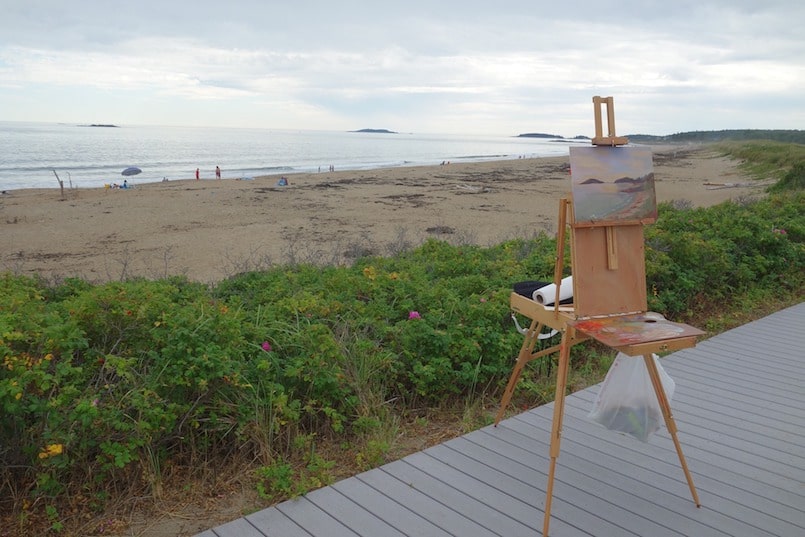
[Photo credit: Coloringcuties & Pixabay]
This Field Easel has taken just a couple of minutes to set up. The plastic bag below the easel is useful for extra materials or litter and adds a little extra weight to the base.
And note how a relatively small canvas has been positioned near the top of the easel, but doubtless at a comfortable height for the artist to stand and paint.
On the other hand, if your work is generally done indoors, then do you have a spare room to use as a studio, or like many artists, do you have to compete with preparing meals/kids doing homework on the kitchen table for instance?
 [Photo credit: Francois Web & Pixabay]
[Photo credit: Francois Web & Pixabay]
OK, this extreme of art and food sharing the same space may not be entirely typical, but it sure can cause friction, even if it's you that's having to do both!
If it's a dedicated painting room, a static easel is great but still needs to fit in the space available so you can freely move around it (there's always something behind an easel - a box or a cupboard - that you need to get to occasionally!)
 [Photo credit: Bridgesward & Pixabay]
[Photo credit: Bridgesward & Pixabay]
If you need to move it now and again or it's not in use for a period, can it be at least folded flat to save space?
If space is tight such as in an apartment, then a table easel might be the answer, or possibly a lightweight portable upright version that can be quickly moved temporarily out of the way with the canvas still on it, without jeopardising your work.
If you split your painting time equally between home and somewhere else, such as college, then you may want an easel that is sturdy enough to withstand commuting but light enough to carry under one arm or via a strap on your shoulder.
Q3. What Size Do You Want To Paint - And In What Media?
I agree that the media you use is relevant but don't get too fixated on it as the most significant factor in your choice of an easel.
Mentally, we tend to think of watercolours and pastels as lightweight, whereas oils and acrylics conjure up an impression of heavy and large and therefore a bigger easel. Yet there are many beautiful large watercolours and equally appealing miniature oil and acrylic paintings.
Remember too, that if you're using a single sheet of watercolour paper or pastel it will need to be taped to a stout board, which is the real size you need to take into account when attaching it to the easel.
If your paintings are all around say, 18" x 14" (45cm x 35cm) or less and usually in watercolour or a dry media, then you'll certainly be happier with a lighter weight easel than if you're using oils and trying to create 6 feet x 4 feet (1.8m x 1.2m) masterpieces on it.
However, there's no hard and fast rule on this because, when required, even a decent lightweight sketching easel can comfortably handle something like an occasional 24" x 18" oil painting, for instance.
If you paint/draw in a range of media and sizes, then it's probably best to start with this type of portable easel because it's perfect for all the smaller paintings, can be set from the horizontal to the vertical and you'll be able to gauge when it (you) struggle to support larger items.
Coming back to the media you use, there are some factors though, that are important.
I mentioned earlier about the advantages of an easel holding a canvas upright to keep dust off oils or tipped slightly forward to allow pastel dust to drop clear of the picture.
With watercolours, you may well want to have the board on which the paper is taped lying almost flat to create more gentle blending or glazing.
Equally, an easel that allows the painting to be held horizontally for say varnishing means you don't have to find a suitably-sized table at home, with the threat of varnish dripping onto the carpet or the table itself.
An often overlooked component when choosing an easel is a hidden one - that is, where do you keep your palette, brushes and other materials whilst actually painting?
In the archetypal scene of an artist at their easel, they are holding a traditional kidney-shaped palette in one hand while flourishing a brush in the other, with several more in their teeth and paint tubes scattered on the floor.
That may suit some, but the majority of us prefer to work with a separate table alongside the easel, or at least have a shelf on it which holds brushes, a few tubes of paint and so on.
These artists, for instance, are enjoying a day painting together and happily sharing a lightweight table for their materials.
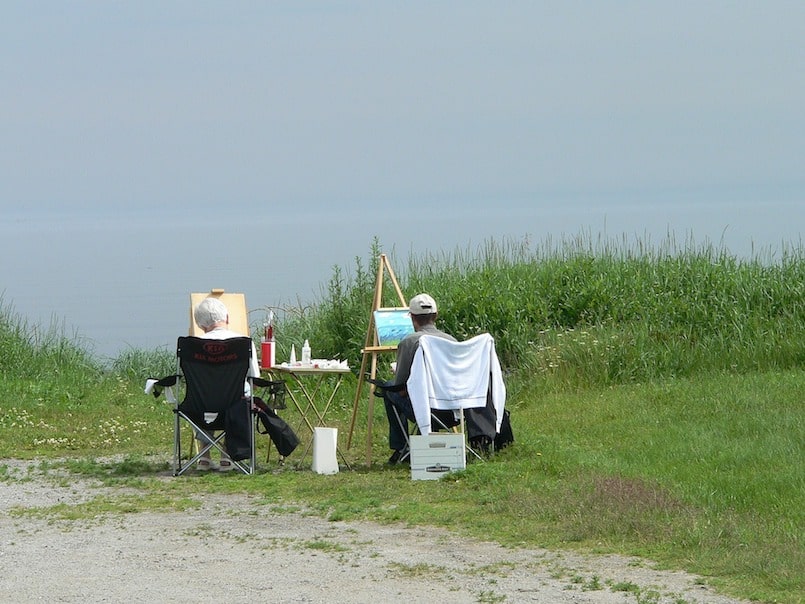
[Photo credit: Pixabay]
Note the two different types of easel and the quite different sizes of painting being produced. A lightweight chair is also essential if you're going to sit to paint, all of which adds extra weight and bulk to what you need to carry.
It's an undeniable fact that watercolours generally require less equipment than other media such as acrylics and oils, but even then, the watercolourist needs somewhere to put things down so they're within easy reach when next needed.
And a pastellist, of course, has dozens of tinted sticks of colour surrounding them as they blend and layer...
Many of the easels we'll look at have convenient shelves or even storage compartments built into them and if you think this will help you to keep things tidy, then this may be the way to go for you.
So, a few more points to think about before diving in and parting with your hard-earned cash!
Q4. Do You Prefer To Stand Up Or Sit Down?
This is purely down to personal preference. Someone working at a table easel may want to continue this way because they like to rest their arm on the table for support.
On the other hand, many artists value the sudden freedom they acquire when they start to stand up to paint at an easel, finding a solution to creating looser work that they may have craved.
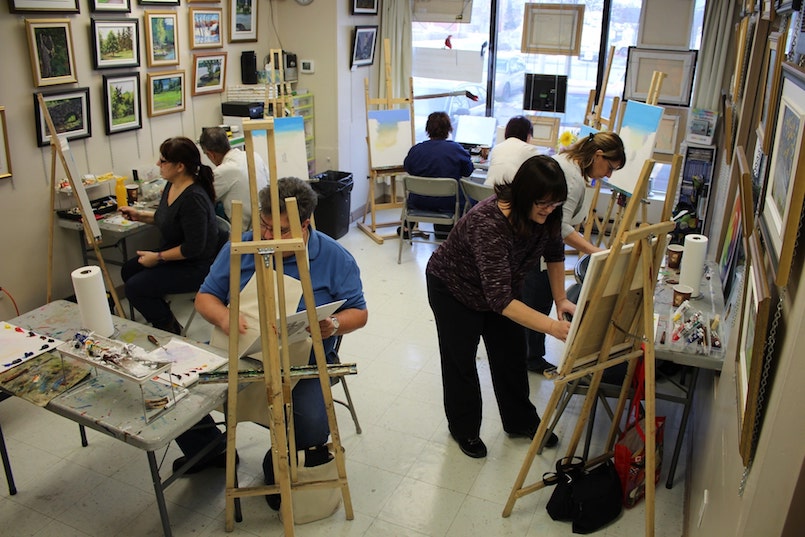
[Photo credit: Pixabay]
This is particularly the case when you're working on a larger item. As I mentioned earlier, your painting arm comes into play so you can execute broad, confident strokes, instead of 'pecking' at the canvas with a small brush.
On the other hand, if you're into highly detailed work, a table easel can be a real boon. The added height at the rear of an angled table easel makes it so much easier to paint comfortably at the top edges of a canvas, as it slopes towards you.
In this class, seven people are happily painting in a mix of standing and sitting at easels. By the way, the lady standing in the right foreground of the photo above might think about moving the canvas up her easel somewhat.
Otherwise, that pose suggests she'll be crying "Oooh, me back", later on in the day!
Q5. What's Your Painting Style?
You may have a gentle, delicate way of painting which sits perfectly with a small desk-top easel or at least a lightweight stand-up version. So a large, heavy static model bristling with cranks, ratchets and thumbscrews would be complete overkill.
Or, you may be the sort of artist who loves to attack their canvas with brushes, paint and knives and relies upon the easel to unflinchingly resist this barrage of aggressive colourizing without it retreating on its castors as you follow it resolutely around the studio.
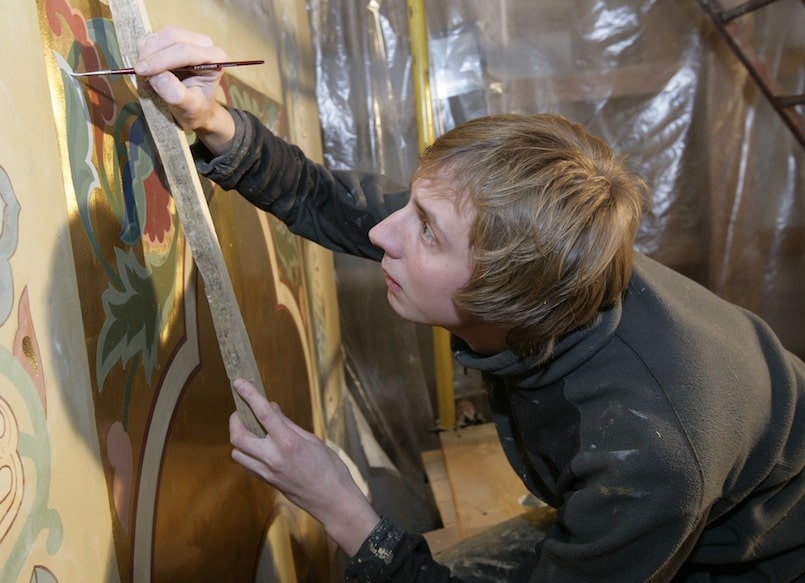
[Photo credit: Pixabay]
Probably, you're somewhere in between, but thinking about this beforehand may save you a considerable sum of money as well as disappointment in your choice.
Types Of Easel
Now let's get down to looking at specific easels because there is a truly bewildering range of makes and models.
For each type, I've given a brief description with some of the pros and cons of each.
I've also included some general weights and key measurements as a general guide, but obviously, they will vary slightly according to the brand.
I haven't mentioned the price because again, there is so much variety between individual makes. However, a brief look online or better still, in your local art store where you will get good additional advice, will give you a feel for how much your favoured easel is going to cost you.
1. Outdoor and Portable
Let's look at the outdoor and portable versions first, as these are often suitable for working at home, on a variety of media.
1.1. Lightweight Adjustable Easel
These come in either wood or aluminium and are designed to fold down to a little over 2 feet in length, often with a travelling cover and shoulder strap.
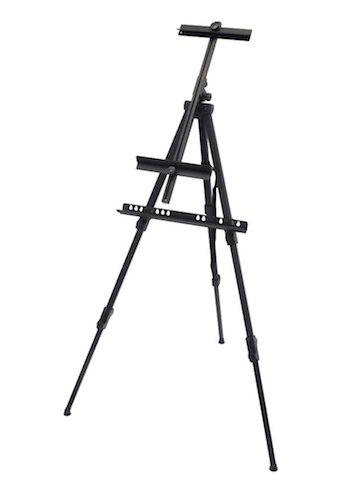
[Photo credit: Ken Bromleys]
Can take canvasses up to almost 4 feet (120cm) in height and the telescopic legs give infinitely adjustable height. This is ideal if it's set up outdoors on uneven ground.
Some models can have the legs fully retracted to act as a table easel.
They weigh between 4 - 5lbs (1.5 - 2kg)

[Photo credit: Ken Bromleys]
Can be a bit unsteady in windy conditions, so you should hold it down with a suitable weight hanging from below the centre.
An ideal secondary use for your backpack or a large water bottle!
However, always remember that it offers a lightweight option to paint plein-air, so take advantage of it. When you paint outdoors, keep your equipment to the minimum!
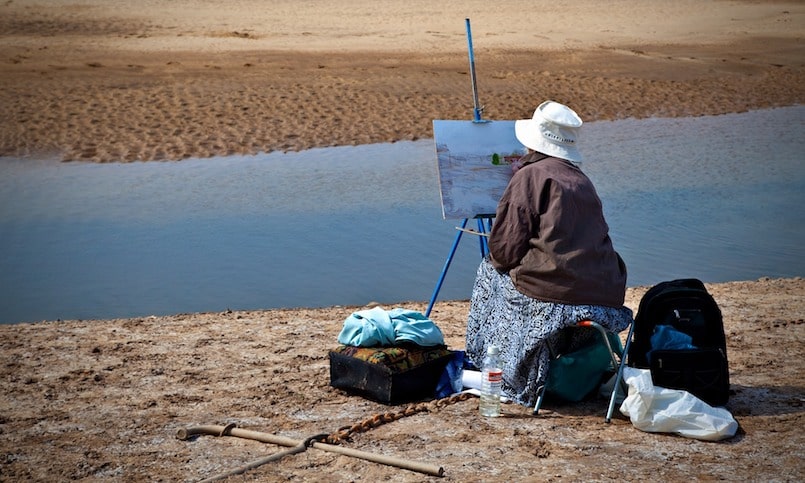 [Photo credit: luxstorm & Pixabay]
[Photo credit: luxstorm & Pixabay]
I suggest you don't follow this lady's example where she looks likes she's taken the family's luggage for a week's holiday along with her.
Suitcase, large backpack, another bag under the chair, the chair, large bottle of thinners, an extra coat that wouldn't fit in the suitcase - oh and the easel, palette and the canvas. I'm assuming the chain and pipe was already there...
The whole point about painting plein-air is to keep things minimal and lightweight, so you can unpack quickly and get started right away, or more importantly, pack up rapidly if the weather suddenly turns foul.
Don't underestimate wind either. Remember, when you put your board or canvas onto the easel, this will act as a sail and even mild gusts will keep you on your toes.
I'm not trying to put you off a lightweight easel, they're fine in most conditions, but you need to paint outdoors just once in average weather to fully understand the need for stability!
1.2. Field or French Easel
This is a bit heavier but is still very portable and has the advantage of greater stability.
It also has a compartment for materials, which usually includes a wooden palette, which in this example, could be rested on the partially open drawer as you paint.
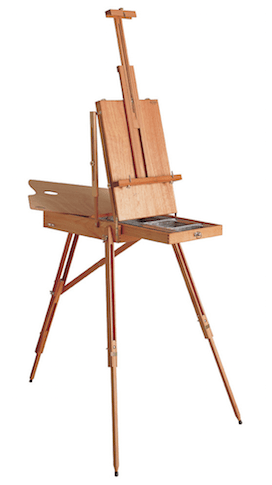
[Photo credit: Ken Bromleys]
When working outdoors it can often provide a means of bringing home a completed painting by clipping it to the inside or outside of the box, depending on the size (and how wet it still is!)
The solid wooden construction will, if looked after, last for many years.
It also folds down to a neat package, which is ideal for transporting or if you need to make some room after using it at home.

[Photo credit: Ken Bromleys]
The canvas holder can be angled from the vertical to the horizontal, so is equally suitable for oils and acrylics as well as watercolours and dry media.
Weight is around 13lbs or 6 kg and takes up a triangular footprint around the perimeter of the legs of around 30".
It will take canvasses up to around 36" and is equally at home outdoors or in the house.
1.3. Painting Horse or Donkey
Moving up the scale, again for indoor or outdoor work, is the Painting Horse, sometimes known as the 'Donkey'. The built-in seat is a bonus and has a large materials compartment underneath.
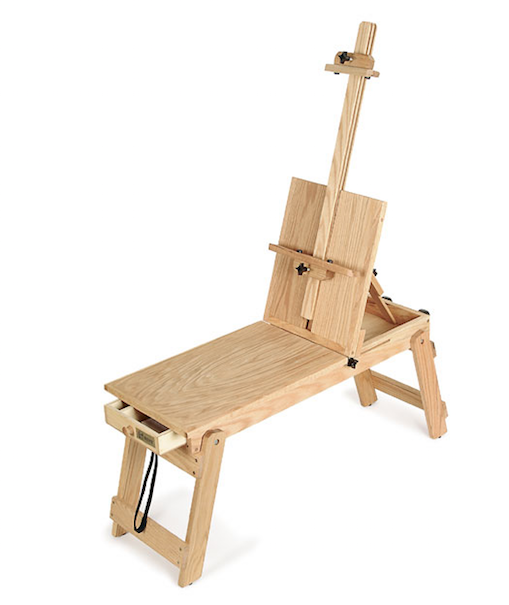
[Photo credit: Dick Blick]
The 'donkey' is well named as a carrier of art materials and a seated artist. It has Germanic origins, as their word for donkey is 'esel'.
There you go, another bonus piece of priceless information you always wanted to know!
Somewhat heavier than the field easel - about 29 lbs or 13 kg, and around 30" long when set up for a painting, many examples have wheels to help move them around when folded into a pretty slim package, which only takes a few moments.
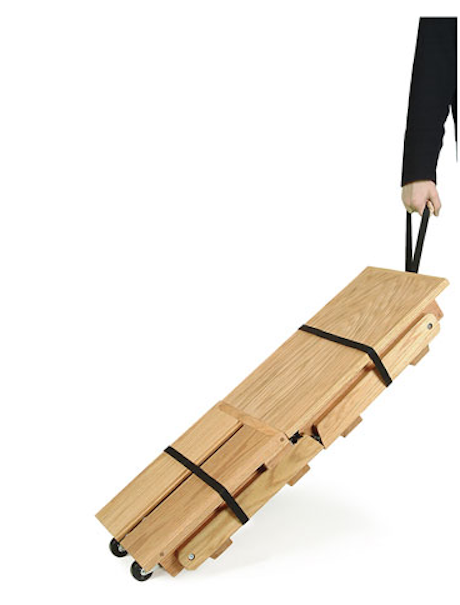
[Photo credit: Dick Blick]
Not quite as large a canvas maximum height as the others at around 27" but perfectly adequate for most work, especially if you think that a 27' high canvas could be about 40" wide or more!
Very stable, especially when the donkey has a passenger!
As a comparison for weight, many budget airlines limit you to 15kg or about 33lbs for a single suitcase, so if flying, you'll almost certainly need to check the donkey in as hold luggage.
Sadly, the same will probably apply for the wooden Field Easel as although there's no weight issue, the compressed length may well be outside the limits for cabin bags, the permitted size of which keeps getting ever smaller...
You may, however, get away with an aluminium version if it folds to the size of a table easel and is less than about 22" (around 56cm) in overall length. As always, check with the airline first.
1.4. Pochade Box
One outdoor option that isn't actually an easel, but which I must mention, is the Pochade Box.
This is a compact wooden box that enables its lid to be opened and fixed at a convenient painting angle with butterfly nuts at the hinge point, allowing a canvas to be rested on it, with the whole box sitting on your knee or on a table.
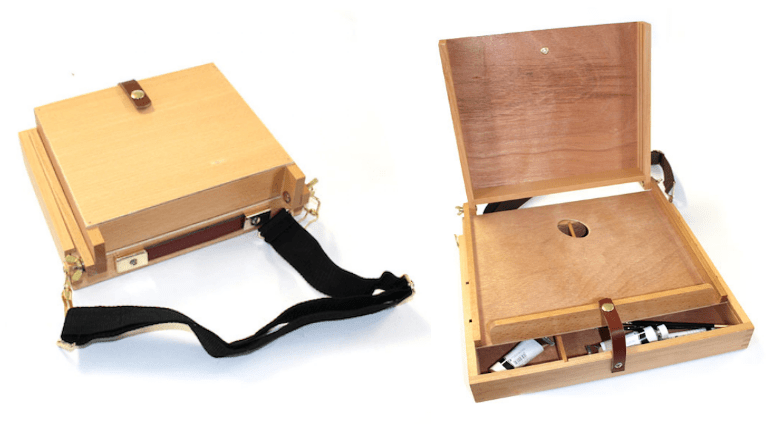 [Photo credit: Ken Bromleys]
[Photo credit: Ken Bromleys]
It also contains a wooden palette for use with oils but the box is equally useful for watercolours or other media.
It carries all your painting materials and it has a convenient handle and shoulder strap.
Although the canvas you could use can be somewhat larger than the dimensions of the box, if you use a canvas panel that fits the supporting slots within the lid, this will also hold the completed painting inside and clear of anything, to protect it on the trip home.
Overall, the pochade box, like the other outdoor easels, is equally suitable for working indoors as well, taking up the minimum of space.
The smaller versions are around 10" x 9" x 4" and weigh just a couple of pounds (1kg), though there are slightly larger versions available.
2. Indoor Easels
Moving on to Indoor Easels, we'll look at table easels first, as they too obviously, have a large degree of portability.
2.1. Table Top Easels
These can be set up in moments and usually have an adjustable support on which to lay your canvas. This might be some sort of wingnut adjuster, allowing variable angles of repose, or it could be a notched system, as below, allowing three or four angled positions.
Around 15'' x 10'' x 2'' (38cm x 25cm x 5cm), weighing a little over 1lb (1/2 kg), although larger sizes are available.
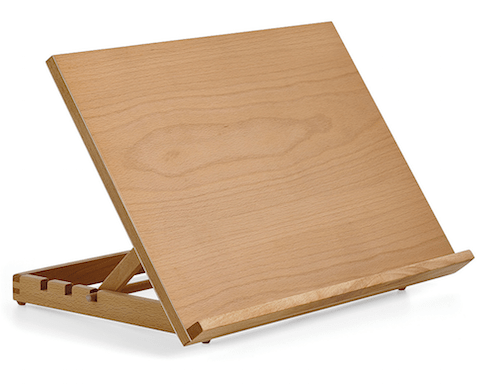
[Photo credit: Ken Bromleys]
Slightly more sophisticated is the tabletop easel with a compartment for materials and the lid acting as the support, such as this example.
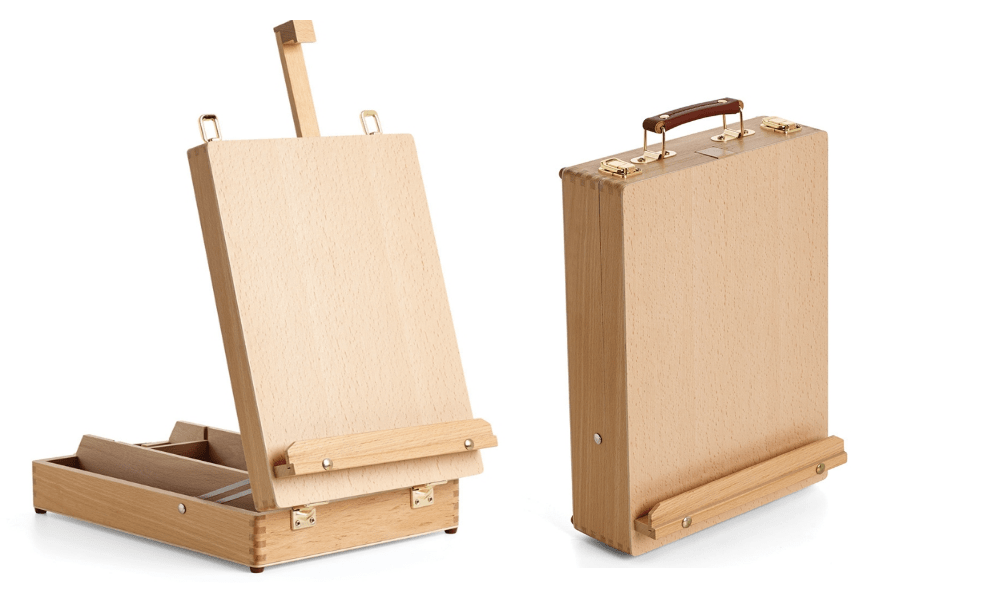
[Photo credit: Ken Bromleys]
As you can these easels fold down into a really easily-carried, compact item, similar to the pochade box, but with the canvas resting on the outside of the box lid.
Sizes vary slightly but folded dimensions are typically about 15" x 11" x 4" (38cm x 28cm x 10cm) and weigh less than 2lbs (1kg) when empty.
The maximum canvas height is about 24", with the bottom ledge accommodating canvasses up to around 3/4" (2 cm) thick.
Moving on a step further, a similar easel can be acquired which has a canvas holder that drops below the table edge, if necessary.
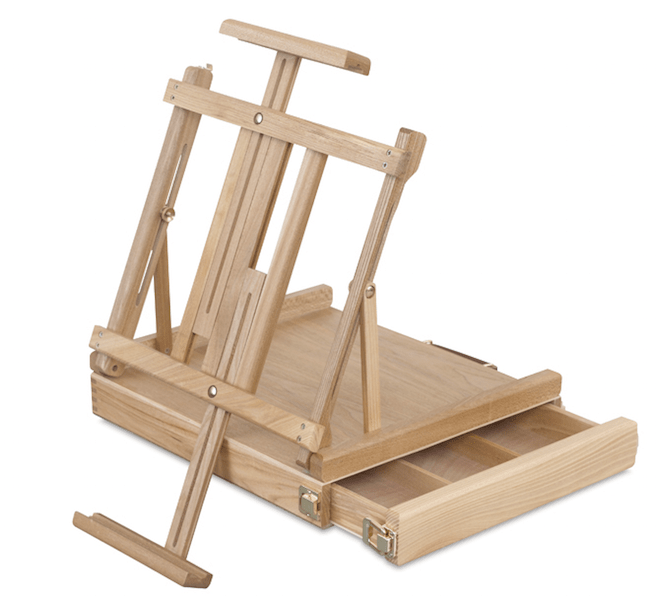
[Photo credit: Dick Blick]
Overall dimensions are similar to the ones above but the canvas height is greater, about 34" (85cm), due to the ability of the canvas holder to go below the front of the table, offering a versatile painting position.
2.2. Camera Tripod Mounting Plate
Now, if you are a photographer, or you have a suitable camera tripod, this one might save you the cost of an easel altogether!
You can easily fashion a suitable board from, say, a piece of 9mm plywood, big enough to hold your usual paintings, or as in this example, use a paper stretcher.
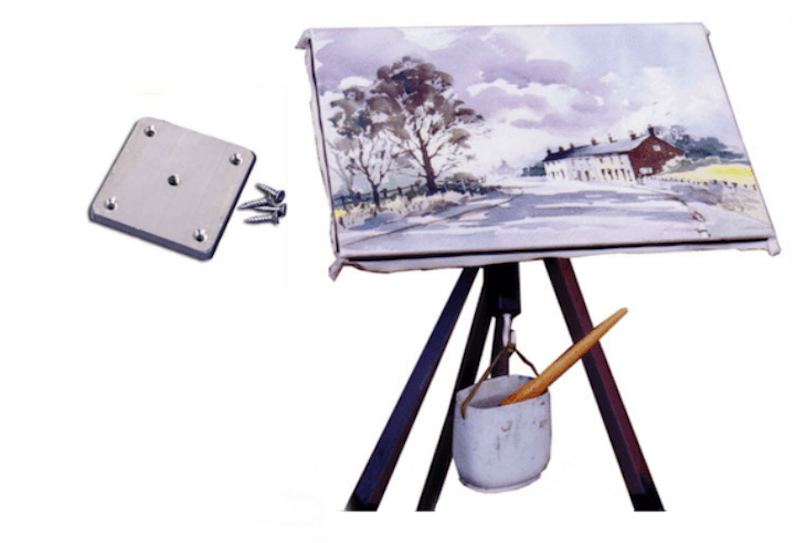
[Photo credit: Ken Bromleys]
By purchasing an aluminium camera tripod plate, which is only around 3" (8cm) square, you can attach it to the underside of your board and then secure to the tripod using the standard screw thread.
Depending upon the sophistication and size of your tripod, you can adjust the board to any angle, including flat to upright and at a comfortable working height.
2.3. The Block of Wood
And don't overlook probably the cheapest solution of all for a table easel!
That is, to place a length of about 2" x 2" (5cm x 5cm) square timber (or a large book or box around the same depth) underneath a suitably-sized board - ply, MDF, chipboard etc) so that it slopes towards you.
It's amazing the difference it makes in allowing you to work more comfortably at a table and you could add further supports to raise the level of the board to match that of a bought table easel. This will enable you to decide if it's worth the outlay or whether the block of wood and homemade board is good enough.
If you look at many of our videos, you'll see that we use this system on many occasions where the tutor needs to sit at the table to describe or demonstrate techniques and materials, especially but not exclusively in watercolours. It works for us and it's comfortable for the artist too.
3. Larger Easels
As we've seen, all of the easels we've looked at so far can be used equally well outdoors or indoors, so there may already be a solution for you there.
However, moving now towards easels which tend to stay in one place, the costs obviously start to rise, as does the size and weight.
Nevertheless, there are easels available which though primarily intended to be left where they are, can be folded down for storage if necessary and compare quite well to the cost of the others we've already looked at.
3.1. A-Frame or Lyre Easels
The A-frame easel's shape is self-explanatory as you can see from the photo below.

[Photo credit: Ken Bromleys]
The 'lyre' description relates to its supposed similarity to the ancient harp-like instrument of the same name.
Google 'lyre images' though and if you can explain to me how this lyre being held by this statue is the same shape as an A-Frame easel and more importantly, how or what he'd be able to paint on it, you're much more skilled than me and really should be doing this blog instead...
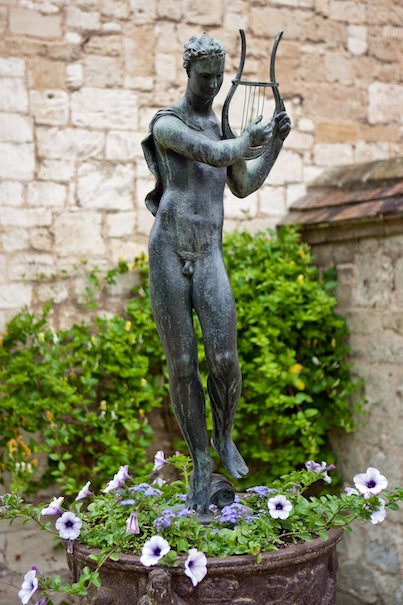
[Photo credit: Ron Porter & Pixabay]
Anyway, A-Frames have the advantage of being pretty lightweight yet stable due to the three-legged adjustable footprint. That means they can be fitted into a corner for painting, saving space and can be folded flat when not in use.
They can take a canvas between about 55" and 72" high so are able to cope with most larger works that you might want to produce.
Weight about 9lb (4kg) and folded down is about 6' (1.8m) high so can be carried around to a limited degree.
Significantly cheaper than most H-Frame easels.
3.2. I-Frame or Single Mast Easels
These are cheaper again and being a single mast, are even easier to store and carry around, weighing only around 11lb (5kg). They fold up flat and can handle canvasses up to around 72", with a good range of adjustment, as can be seen from the slot down the centre of the mast.
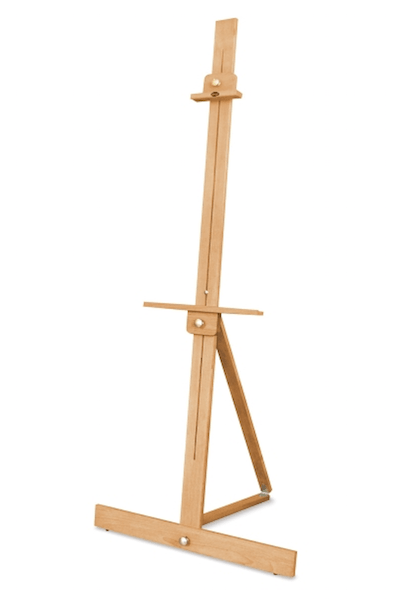
[Photo credit: Dick Blick]
A basic, economical design and good if you're really stuck for space but want to create larger works. Being a single mast, it also may provide a better option for those in a wheelchair than easels such as the H-Frame or A-Frame.
Has about a 36" x 24" footprint, though not quite as stable as other indoor easels.
3.3. H-Frame Easels
The H-Frame easel is the daddy of the bunch, with a solid, sturdy frame that is stable, yet surprisingly adaptable in a number of variations.
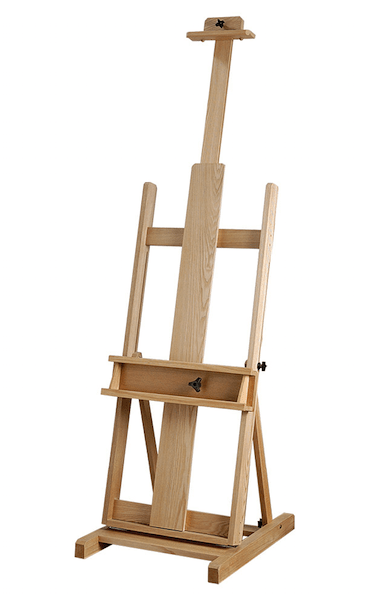
[Photo credit: Ken Bromleys]
For instance, many H-Frames will allow you to tip the picture forwards, lean it back to any angle or right back to the horizontal.
As you can see from the photos below this convertible model means, for example, you don't have to find a table on which to varnish a large picture.


[Photo credits: Ken Bromleys]
If you are prepared to shell out the cash, heavier duty H-Frames come with an increasing solidity, shelves and storage drawers, lockable castors and floor levellers and all manner of ratchets, levers, winders and knobs for adjusting the height, reach and angle that it supports the canvas.
Some are more comfortable than others if you wish to sit at them to paint so do check out this factor before you buy.

[Photo credit: Ken Bromleys]
At the top of the range, beautifully constructed, you can add an electric motor so you don't even have to wind your canvas up and down the easel and for good measure, this can be operated by a switch, foot pedal or even a remote control (yes, another one to lose)!
They just fall short of painting your picture for you...
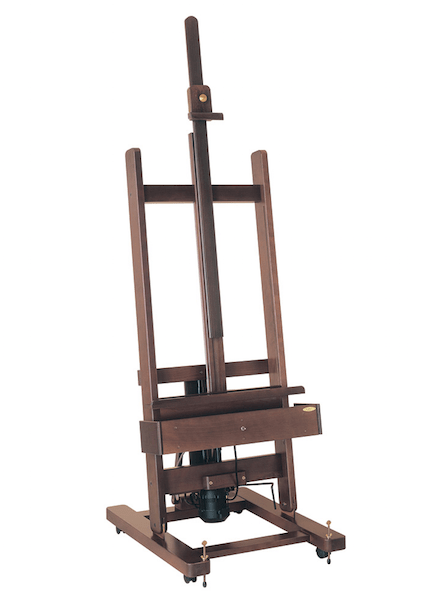
[Photo credit: Ken Bromleys]
The footprint can be around 30" front and side and can typically rise to over 100" high. The biggest models weigh in excess of 70lbs (34kg) or more so you really should have the space to make the most of the facilities it offers.
Incidentally, that height factor is often overlooked until it's too late.
If you have an easel that can be raised to around 10 feet high to accommodate a really large canvas (and many do) and your ceilings are only 8 feet high, the first time you fully extend it, you (or someone in the room above you) are going to have a big problem and you will have spent good money for a facility you can't use.
And quite likely a repair bill for the ceiling...
3.4. Painting Stations or Taborets
For those who don't want a conventional easel cluttering up the place but feel they want somewhere more appropriate to work than the kitchen table then a Painting Station or Taboret may be the answer.
Effectively, this is a table frame or cupboard with a retractable easel in the centre and shelves and drawers either side.

[Photo credit: Dick Blick]
Most models provide the look of a handsome piece of furniture when not in use, so though expensive, it might be an ideal solution for someone who needs to work in a room that is also welcoming to visitors.
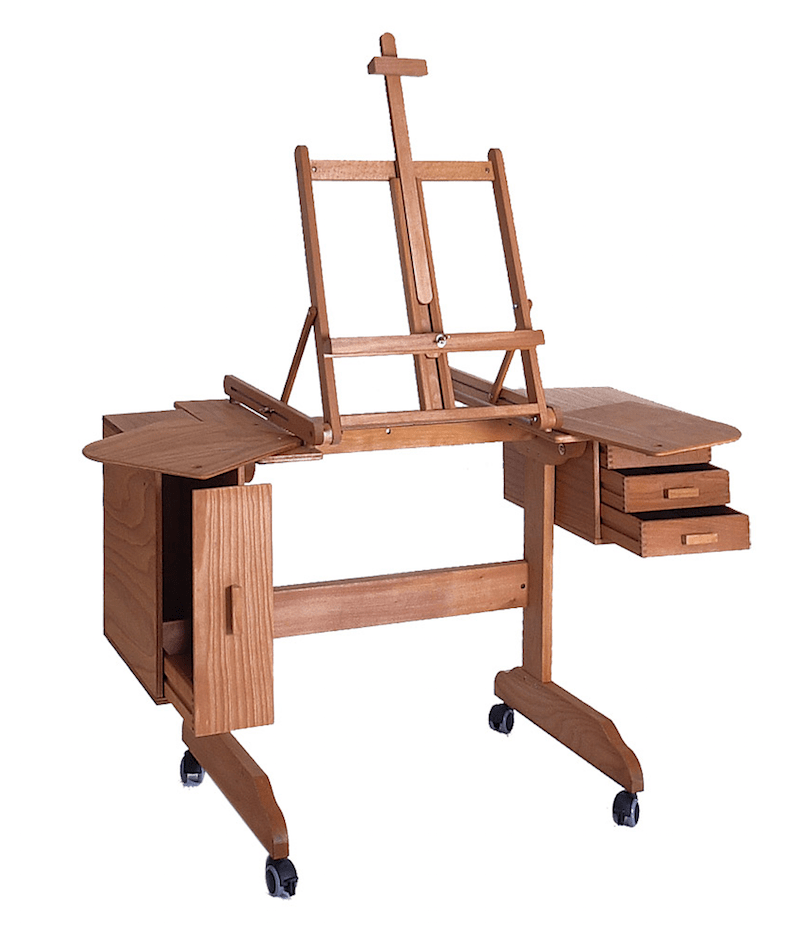
[Photo credit: Ken Bromleys]
For anyone in a wheelchair, this can also provide an effective option where all materials and equipment are ready to hand while providing unimpeded access to the easel itself.
The lower example illustrated has been specifically designed with this in mind.
A Couple of Final Little Tips
Now although I've given a general maximum height that each easel can accommodate, both portable and indoors, there's one other important point you need to remember, regardless of whether you stand or sit to work.
If you stand but want to work on a relatively small canvas, say 12" x 8", you need to be sure that the bottom canvas grip can be raised up to support it and allow you to paint at eye level.
Similarly, if you sit down to work, you need to be certain that the top grip will lower sufficiently to allow you to place your canvas to your liking.
It's an issue that's often overlooked until it's too late and it is inevitable all easels have some limitations as to how far the grippers will travel up or down, depending on the design.
So it's worth spending a little time in the art store or asking a question online (or at a college or where others have a similar easel) to check if there are any significant issues like this that would affect your choice.
The other point I just wanted to add (thanks to a reminder from Colleen, a fellow artist) is to check out the various screws, bolts and levers on your easel and note if they are a special kind, which may be expensive or difficult to replace, if lost or damaged.
You'll find most of them are a regular size or type and something similar or a workaround fix can usually be obtained from the local hardware or DIY store.
However, you don't want to find you're missing a vital bolt if you've travelled for a day's painting, so do check that the equipment is working before you go out and if possible keep a couple of spare nuts or bolts in your paintbox that might well save the day!
Recommendation
As you can see, there are a plethora of easels to choose from out there.
And I've barely scratched the surface of all the brands and subtle variations on each of the particular types.
So many different circumstances will dictate your choice as will, of course, your budget. As I mentioned earlier, you can pay almost whatever you like for an easel.
Here are just a few examples from one or two websites. I've rounded up or down the conversions for simplicity and these will obviously vary over time, depending upon exchange rates:-
- Table easels range from just £10 - £120 GBP ($12 - $150 USD, 12€ - 140€ EUR).
- Lightweight outdoor easels £30 - £200 GBP ($40 - $250 USD, 35€ - 235€ EUR).
- I-Frame Easels £40 - £240 GBP ($50 - $300 USD, 50€ -285€ EUR)
- A-Frame Easels £75 - £250 GBP ($95 - $320 USD, 90€ - 300€ EUR)
- H-Frame Easels £130 - £2000+ ($160 - $2500 USD, 155€ - 2375€ EUR)
- Painting stations £750 - £1500+ ($950 - $1900 USD, 890€ - 1780€ EUR)
So you can see that there's a crossover in prices right across the ranges and types of easel.
What I would say is that if it's your first easel, a lightweight aluminium or wooden model offers a lot of options for not too much of an outlay for the beginner.
Those at the lower end of the price scale will be more than adequate for most people.
I remember buying my first easel, which was a fairly cheap wooden sketch model, which is still going strong over 25 years later.
I've used it indoors and outside, with a board for watercolours and both stretched canvasses and canvas panels, even up to around 30" x 20", for demonstrations as well as personal use.
Personally, if I was starting again I would go for an aluminium model because it's lighter and if you get a version that doubles as a table easel, then that's a bonus.
It doesn't take up too much space indoors, folds down to almost invisible and is easy to carry if you're working outside.
As I said earlier, it can also handle the occasional larger canvas and can be tilted to the horizontal if necessary, so suiting most wet and dry media.
It will also provide a chance for you to assess your painting needs and will expose any limitations in its use which may clarify why you may want (or not want) a particular feature in a different type of easel in the future.
There's no 'one size fits all' option and many artists have more than one easel for this reason.
However, the type I've suggested will at least give you the flexibility to cover many situations at the outset, both indoors and outdoors, without breaking the bank.
And hopefully now, if you've read this far, you're a little clearer on some of the decisions you need to make when considering your next (or even if you need one!) easel!
Never Miss a Blog Post!
I'll send you a short email whenever I publish a new blog post (which is most weeks)...
I will never send you spam or pass tyour email address to any third party

